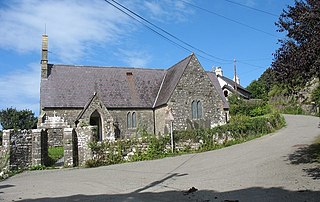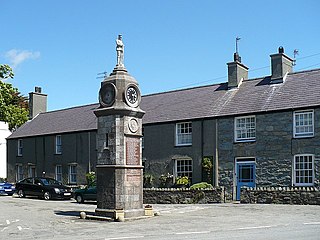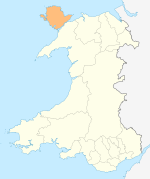
Llannerch-y-medd, is a small village, community and post town on the Isle of Anglesey in Wales. The Royal Mail postcode is LL71, and it has a population of 1,360, of whom more than 70% is Welsh speaking.

Benllech is a large village on the Isle of Anglesey in Wales. It is in the community of Llanfair-Mathafarn-Eithaf, which has a population of 3,382, making it the fourth largest settlement on the island of Anglesey. The name of Benllech village had been removed by the time of the 2011 census with the community being listed under Llanfair-Mathafarn-Eithaf with the electoral ward being listed under Llanddyfnan. The built-up area has a population of 2,236.

Moelfre is a village, a community and, until 2012, an electoral ward on the north-east coast of the Isle of Anglesey in Wales. The community area covers the village and harbour, and several smaller, dispersed settlements. It includes six scheduled Iron Age hut groups and many other sites of archaeological interest. The harbour was formerly a local fishing port; a lifeboat station has been based here since 1854. Among many shipwrecks off the coast was that of the Royal Charter in 1859. Near the modernised lifeboat station is the RNLI Seawatch Centre. The coastline includes a rocky headland north of the village and a large sandy beach at Lligwy Bay, both traversed by the Anglesey Coastal Path. The 2011 census measured the village population as 710. It was estimated at 614 in 2019.

Plas Newydd is a country house set in gardens, parkland and surrounding woodland on the north bank of the Menai Strait, in Llanddaniel Fab, near Llanfairpwllgwyngyll, Anglesey, Wales. The current building has its origins in 1470, and evolved over the centuries to become one of Anglesey's principal residences. Owned successively by Griffiths, Baylys and Pagets, it became the country seat of the Marquesses of Anglesey, and the core of a large agricultural estate. The house and grounds, with views over the strait and Snowdonia, are open to the public, having been owned by the National Trust since 1976.

Llys Rhosyr, also known as "Cae Llys", is an archaeological site near Newborough in Anglesey; the ruins of a pre-Edwardian commotal court. The Welsh word llys originally referred to an enclosed open-air space but gradually took on the meaning of a place where legal proceedings took place and was gradually extended to refer to royal "courts".

St Mary's Church, Pentraeth is a small medieval parish church in the village of Pentraeth, in Anglesey, north Wales. The date of construction is unknown, but is probably from some time between the 12th to 14th centuries. A church dedicated to St Mary was recorded here in 1254, but there is a tradition that there was an older church dedicated to St Geraint, an early British saint. Some medieval stonework remains in three walls of the building. A chapel was added to the south side in the 16th or 17th century. The church was altered and refurbished during the 19th century, including an extensive rebuilding by Henry Kennedy, the architect for the Diocese of Bangor, in 1882. St Mary's is still used for worship by the Church in Wales, and is one of three churches in a combined parish. Its conservation is specifically included in the aims of a Chester-based charity that promotes health and the arts in Anglesey and the north-west of England.

St Tyfrydog's Church, Llandyfrydog is a small medieval church, in Llandyfrydog, Anglesey, north Wales. The date of establishment of a church on this site is unknown, but one 19th-century Anglesey historian says that it was about 450. The oldest parts of the present building are dated to about 1400, with the chancel dating from the late 15th or early 16th century. It is built from rough, small, squared stones, dressed with limestone. One of the windows on the south side is raised to illuminate the pulpit, a decision that in the eyes of one 19th-century commentator "disfigures the building."

Capel Lligwy is a ruined chapel near Rhos Lligwy in Anglesey, north Wales, dating back to the first half of the 12th century. The chapel's original purpose is unknown, but it might have been used as a memorial chapel or in connection with a local royal court, or as a chapel of ease in a large parish with a growing population. It was used for a time until the early 18th century as a private place of worship for a nearby house, then later fell into disrepair. The walls still remain, with some traces of render on them internally, but there is no roof.

St Dona's Church, Llanddona ) is a small 19th-century parish church in the village of Llanddona, in Anglesey, north Wales. The first church on this site was built in 610. The present building on the site dates from 1873, and was designed by the rector at the time. It reuses earlier material including a decorated 15th-century doorway and a 17th-century bell.

St Gallgo's Church, Llanallgo is a small church near the village of Llanallgo, on the east coast of Anglesey, north Wales. The chancel and transepts, which are the oldest features of the present building, date from the late 15th century, but there has been a church on the site since the 6th or early 7th century, making it one of the oldest Christian sites in Anglesey. Some restoration and enlargement took place during the 19th century.

Llanallgo is a small village a mile from the coast of the island of Anglesey. The community is in the community of Moelfre, Ynys Môn, Wales, which is 136.4 miles (219.6 km) from Cardiff and 214.9 miles (345.9 km) from London.

Llanfechell is a village in Anglesey, Wales. It is the largest of several small villages and dispersed settlements that make up Mechell Community Council area. It is 11 miles (18 km) east of Holyhead, and 5.6 miles (9 km) west of Amlwch, in the north of the island.

St Beuno's Church, Trefdraeth is the medieval parish church of Trefdraeth, a hamlet in Anglesey, north Wales. Although one 19th-century historian recorded that the first church on this location was reportedly established in about 616, no part of any 7th-century structure survives; the oldest parts of the present building date are from the 13th century. Alterations were made in subsequent centuries, but few of them during the 19th century, a time when many other churches in Anglesey were rebuilt or were restored.

St Eugrad's Church, Llaneugrad is an isolated church near the village of Marian-glas, in Anglesey, north Wales. A church was supposedly founded here by St Eugrad in about 605, although the earliest parts of the present structure are the nave, chancel and chancel arch, which date from the 12th century. A side chapel was added to the north in the 16th century, and some moderate restoration work was carried out in the 19th century. It contains a 12th-century font, a 13th-century carved stone depicting the crucifixion, and a memorial to one of the officers killed when the Royal Charter sank off Anglesey in 1859.

St Beuno's Church, Aberffraw is a 12th-century parish church in Anglesey, north Wales. A church was established in Aberffraw in the 7th century by St Beuno, who became the abbot of Clynnog Fawr, Gwynedd. St Beuno's may have been used as a royal chapel during the early Middle Ages, as the princes of Gwynedd had a court in Aberffraw. The oldest parts of the church date from the 12th century, although it was considerably enlarged in the 16th century when a second nave was built alongside the existing structure, with the wall in between replaced by an arcade of four arches. Restoration work in 1840 uncovered a 12th-century arch in the west wall, which may have been the original chancel arch or a doorway to a western tower that has been lost. The church also has a 13th-century font, some memorials from the 18th century, and two 18th-century copper collecting shovels.

St Ceinwen's Church, Cerrigceinwen, is a former parish church in the countryside of central Anglesey, north Wales. The present building dates from 1860, although the site has been used for worship since at least the 7th century. The doorway reuses some old carved gravestones, one from the 9th to 11th centuries, and another from the 12th century. The church grounds contain a well, once thought to have healing properties. The church and the well are both named after St Ceinwen, an early Celtic female saint.

St Peter's Church, Llanbedrgoch, is a small medieval parish church near the village of Llanbedrgoch in Anglesey, north Wales. The oldest parts of the building date from the 15th century; it was extended in the 17th century and restored twice in the 19th century. The doorway is decorated with carvings of two human heads, one wearing a mitre. The church contains a reading desk made from 15th-century bench ends, one carved with a mermaid holding a mirror and comb.

Parciau hill fort is a hill fort on the Welsh island of Anglesey. It stands on the summit of Bryn Ddiôl, whose name means "trackless hill".

St Trygarn's Church is a Church in Wales parish church in the Diocese of Bangor which covers its location at Llandrygarn, Anglesey, Wales. It was built in the 13th century and is a Grade II listed building. The church is the sole monument in Llandrygarn.

Elen Roger Jones was a Welsh actress and teacher.

![]() Welsh pronunciation ) is a small village and post town in Anglesey, north-west Wales. It lies between the larger villages of Moelfre and Benllech and just off the A5025. There is a large caravan park on the edge of the village and several camp sites. There is a church and pub but no shop. It has a memorial to those killed in the two world wars, including a list of 17 seamen from the Merchant Navy. [1]
Welsh pronunciation ) is a small village and post town in Anglesey, north-west Wales. It lies between the larger villages of Moelfre and Benllech and just off the A5025. There is a large caravan park on the edge of the village and several camp sites. There is a church and pub but no shop. It has a memorial to those killed in the two world wars, including a list of 17 seamen from the Merchant Navy. [1] 






















